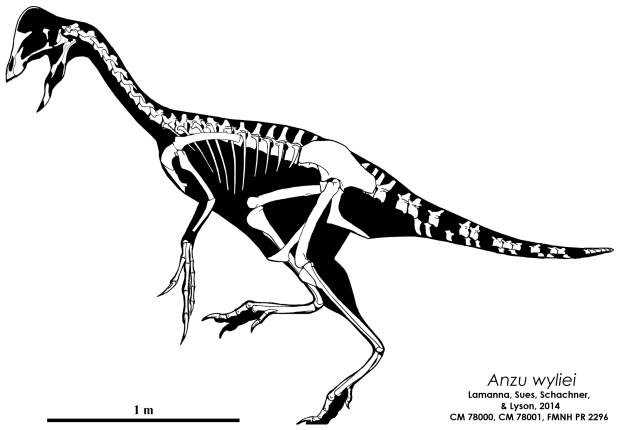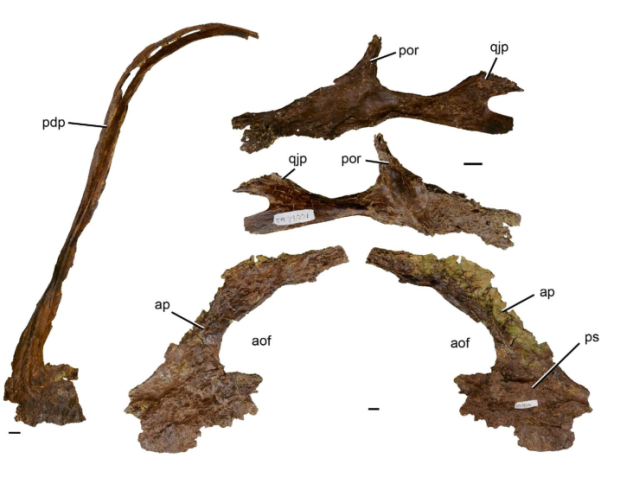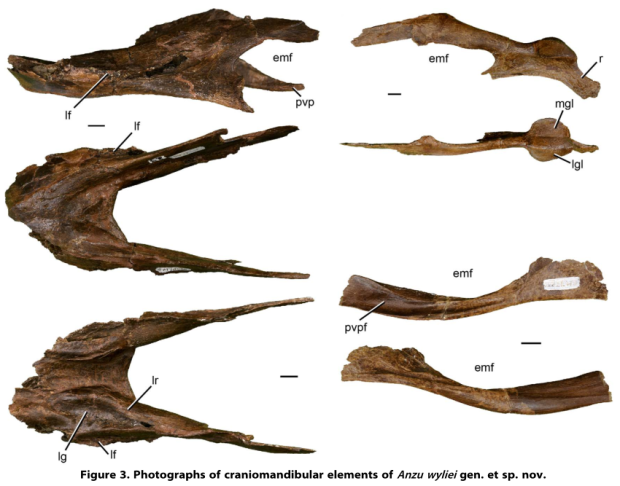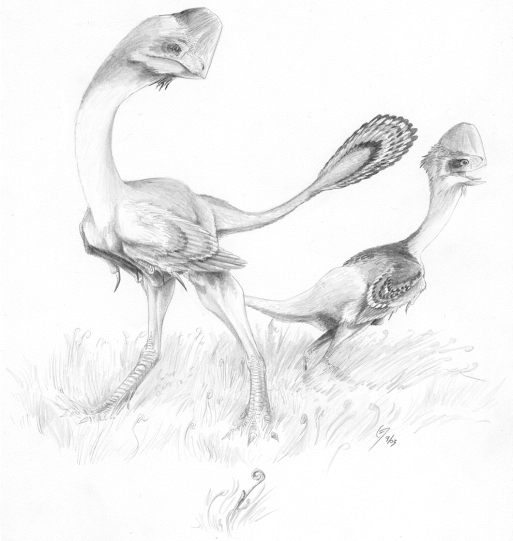In 1998 and 1999 two skeletons were collected from the badlands of the Great Plains of South Dakota, USA. Discovered by Fred Nuss barely 80m apart, they would go on to be one of the most intriguing and strong denizens of the Hell Creek fauna.
(This article originally appeared with a different frontis. The image was borrowed, without permission, from Brian Switek’s article on a possible additional specimen, including foot bones(!) of this species, or even a potential different species. I replaced it with the image above. That image now appears below, with proper attribution and permission.)
But through the long process of preparation and consolidation (a cooperative venture between Nuss and Mike Triebold’s TPI), the bones being heavily damaged through action of roots and geology, the two skeletons eventually become a single animal, and then from there those who’d taken the painstaking task upon themselves to prepare and present the material sought to find a fair home for it. They (being Nuss and Triebold and his merry band of fossil collectors and preparators) wanted a public institution, if possible: the material appeared to represent a new species. Called Triebold’s oviraptor, or an unnamed caenagnathid, or the Hell Creek oviraptorosaur, this specimen would become famous, mounts of it cast and sent around the world. For years, the specimens were called “Triebold’s oviraptor,” “Trieboldraptor,” and even an informal nod toward Caenagnathus or Chirostenotes.
Specimens of this animal have been discovered before. A fragment of one was mixed up with Sue, the giant tyrannosaur that ended up at Chicago’s Field Museum, but it was so incomplete not much could be made of it, as little else was known of caenagnathids. But these two specimens, representing most parts of the skeleton, provided substantial information.

Skeleton of Anzu wyliei Lamanna, Sues, Schachner & Lyson, 2014. Drawn after Scott Hartman’s and thus a complete ripoff. Modifications will be made at some point with new data now published. Manus and pes are not as complete as illustrated.
Those specimens ended up at the Carnegie Museum, and so began work to fully describe and relate them to the awaiting world. On Wednesday, 19 March, the specimens were crowned by the Carnegie’s Matt Lamanna, the Smithsonian’s Hans-Dieter Sues and Tyler Lyson, and by University of Utah’s Emma Schachner. Anzu wyliei, named for a Sumerian demigod which took avian form (and also incidentally a very coincidental bird “god” with enormous hand claws in the game World of Warcraft, named for the same reason) and also the Wylie Tuttle, whose grandparents had given musch support to the Carnegie Museum where the specimens now reside, meets the world.
(As an added bonus, Anzū translates as “to know heaven” and has been characterized as a gryphon-like figure, which is comparable to the second largest oviraptorosaur from North America, Hagryphus giganteus.)
It stands almost 8 feet, 5 at the shoulder and the rest head and neck. Much like an ostrich or some demented chicken-monster, Anzu like other oviraptorosaurs would have been a fully feathered, long-legged bird-like dinosaur. The head is crowned with what has been called a “dinner plate” of a crest, much like some hadrosaurs, though it doesn’t seem to be hollow, also unlike many crested oviraptorids.
An oviraptorid it is not, but a caenagnathid; and what that meant has been debatable. In the early 1920’s the Sternberg family had discovered a trove of fossils at a site in Alberta along the Red Deer River called Steveville. Specimens from this trove included fragments of this or that species. Charles Gilmore named the first of these fragments (a partial pair of hands) Chirostenotes gracilis. The Sternbergs would add a partial foot (Macrophalangia canadensis) and then a real prize: a fused pair of mandibular rami, forming nearly an entire lower jaw, Caenagnathus collinsi. Another partial jaw, Caenagnathus sternbergi, would join later, from Joel Cracraft. It would not take long before someone started speculating these would all belong to a similar type of animal. Yet even earlier a partial foot had been discovered named by William Parks: Ornithomimus elegans. I go into far more depth on this topic, why the species should stay separate, and how to treat them, here. It is refreshing that the paper helmed by Lamanna and colleagues have done much the same.

Cranial fragments of CM 78001, referred to Anzu wyliei Lamanna et al. 2014. Premaxilla, jugal from both sides, and maxilla from both sides. Modified from Lamanna et al. (2014).
Anzu wyliei enters into this debate because it preserves features of each of these animals, and strengthens support that many of them belong, if not to the same animal then to a single grade of animal. Anzu creates the first substantial illustration of what a caenagnathid would look like. Most importantly, it expands the potential variation of jaw morphology in caenagnathids. Over the last few decades numerous partial jaws have been found in Alberta and, now, the southern US, producing a robust idea of jaw variation, which neatly fills in many gaps between the then-suggested variation shown. Small jaws from Texas, such as Leptorhynchos gaddisi, had a straight, upturned jaw, whereas the Alberta jaws varied in being upturned to slightly curved upwards. Anzu wyliei, however, has a relatively flat jaw.
The intricacies of caenagnathid jaws fascinate me, and for various reasons I’ve been looking into turtle and bird jaws to see if these morphological variations are even more interesting, or merely boring. Anything but. Anzu implies much more complexity in caenagnathids, with ridges and deep fossae and whatnot. A trove of fascination. And that’s not all preserved of the head: the upper jaw is there, and this allows comparison of the jaw to that of Epichirostenotes curriei, whose skull is known from a maxilla and fragment of palate, along with the rear of the skull, as in Anzu.

Cranial fragments of of CM 78000, holotype, of Anzu wyliei Lamanna et al. 2014. Mandible in dorsal, lateral, and ventral views; surangular-articular-coronoid complex in lateral and dorsal views; and angular in inside and outside views. Modified from Lamanna et al. (2014).
To test their idea of a caenagnathid identity, the authors undertook the most comprehensive phylogenetic analysis covering specifically oviraptorosaurs to date, on the basis of the analysis by Nick Longrich and co-authors describing Leptorhynchos gaddisi. And correcting various codings to separate the lumped in species so that holotypes and specimen complexes attached to names would be correctly evaluated without conflating assumptions of referral. Adding in new characters, the most complete set of relationships for caenagnathids has been recovered.
One of these was the recovery of the positively titanic Gigantoraptor erlianensis as a caenagnathid. I’d hypothesized this a while back, but since then new analyses have supported caenagnathid relationships, including Longrich’s analysis. Lamanna’s new matrix further supports this relationship, and I think at this point the relationship is convincing.

Phylogeny with geological timescale showing when species were present. Long I-shaped bars under taxon names represent approximate times of existence and thus uncertainty. From Lamanna et al. (2014).
It should be noted that Anzu wyliei comes from the Hell Creek Formation, and was thus a contemporary of the latest nonavian dinosaurs. Tyrannosaurus rex. Triceratops prorsus. Ankylosaurus magniventris. As one of the last oviraptorosaurs, it occurs almost 10 million years after the caenagnathids of Steveville, amongst which it is nested. First, this is not surprising given that only a few species are known with relatively complete mandibles and many more, including Epichirostenotes curriei and Ojoraptorsaurus boerei, are not. But those taxa are also both older than Anzu, and younger than the Steveville taxa, which makes them important and potential intermediates. We will need more data to properly assess these taxa.
Anzu was also a contemporary of Ornithomimus elegans, referred by the authors as some do and should as Elmisaurus elegans (rather than, say, as Chirostenotes elegans, and synonymized with Chirostenotes sternbergi on account merely of gracility). There is also the tiny Lancian “parrot,” from the contemporaneous Lance Formation, but this is the subject of ongoing research. Elegans is primarily known from the Dinosaur Park Formation, which is late Campanian in age, but the Hell Creek material referred to it is morphologically very similar, but may indeed belong to Anzu. This cannot be confirmed, as the Carnegie skeletons lack metatarsal bones.
No matter the final fate of these taxa, the Hell Creek oviraptorosaur has been long due, and its arrival well received.
Anzu has come.
Cracraft, J. 1971. Caenagnathiformes: Cretaceous birds convergent in jaw mechanism to dicynodont reptiles. Journal of Paleontology 45: 805-809.
Currie, P. J. & Russell, D. A. 1988. Osteology and relationships of Chirostenotes pergracilis (Saurischia, Theropoda) from the Judith River (Oldman) Formation of Alberta, Canada. Canadian Journal of Earth Sciences – Revue canadienne de sciences de la Terre 25: 972-986.
Currie, P. J., Godfrey, S. J. & Nessov, L. A. 1994. New caenagnathid (Dinosauria: Theropoda) specimens from the Upper Cretaceous of North America and Asia. Canadian Journal of Earth Sciences – Revue canadienne de sciences de la Terre 30: 2255-2272.
Sues, H.-D. 1997. On Chirostenotes, a Late Cretaceous oviraptorosaur (Dinosauria: Theropoda) from western North America. Journal of Vertebrate Paleontology 17: 698-716.
Gilmore, C. W. 1924. A new coelurid dinosaur from the Belly River Cretaceous of Alberta. Canada Geological Survey Bulletin 38: 1-12.
Lamanna, M. C., Sues, H.-D., Schachner, E. R. & Lyson, T. R. 2014. A new large-bodied oviraptorosaurian theropod dinosaur from the Latest Cretaceous of western North America. PloS ONE 9 (3): e92022.
Longrich, N. R., Barnes, K., Clark, S. & Millar, L. 2013. Caenagnathidae from the Upper Campanian Aguja Formation of West Texas, and a revision of the Caenagnathinae. Bulletin of the Peabody Museum of Natural History 54: 23-49.
Parks, W. A. 1933. New species of dinosaurs and turtles from the Upper Cretaceous formations of Alberta. University of Toronto Studies, Geological Series 34: 1-33.
Sternberg, C. M. 1932. Two new theropod dinosaurs from the Belly River Formation of Alberta. The Canadian Field-Naturalist 46: 99-105.
Sternberg, R. M. 1940. A toothless bird from the Cretaceous of Alberta. Journal of Paleontology 14: 81-85.
Sullivan, R. M., Jasinski, S. E. & van Tomme, M. P. A. 2011. A new caenagnathid Ojoraptorsaurus boerei, n. gen., n. sp. (Dinosauria, Oviraptorosauria), from the Upper Cretaceous Ojo Alamo Formation (Naashoibito Member), San Juan Basin, New Mexico. New Mexico Museum of Natural History and Science, Bulletin 53: 418-428.






Just what i needed for my novel!
(just to keep it short: i’m writing a fantasy novel set in the aftermath of the KT event with a young tyrannosaurus as the main character, and there’s an old oviraptor which is sort of a shaman/seer… Anzu is really, really appropriate name!)
Thanks for sharing this discovery :)
I’ve been waiting for this paper for more than a decade and it was worth it. Another giant relative of Anzu from 35 million years earlier in Utah will be announced informally by one of our speakers at our Mid-Mesozoic conference the first week of May.
This is excellent news. Seems oviraptorosaurs had few constraints on getting particularly large, so I think that is another strike against them being general herbivores. WAY too much competition.
What do you think about Anzu wyliei nesting between Caenagnathus collinsi and “Caenagnathus” sternbergi on the cladogram? Could this just be a new species of Caenagnathus or Chirostenotes or whatever?
Also, hasn’t elegans been referred to Leptorhynchos? Is there some reason to keep it out of that genus and in Elmisaurus?
When it comes to nesting among “Caenagnathus,” I don’t think there’s a problem. A. wyliei might have been Caenagnathus wyliei, but at the same time Caenagnathus sternbergi might not be Caenagnathus. More and more often, there’s a shift toward merely naming new taxon with a unique “genus and species couplet” binomen, and that seems to be true here.
It’s also more interesting and useful to name it in full when you have questions about the diversity of the caenagnathid jaw. Anzu‘s jaw is really distinct, and the authors are gambling that the diversity is high enough this could cause C. sternbergi to get its own name. I think that’s what will ultimately happen.
As for “Leptorhynchos” elegans, this conclusion is far better. Longrich et al. assumed, as did many before them, that the slender jaws of Dinosaur Park belonged to the small articular portion of jaw which was named C. sternbergi. Then, many also assumed that there were only two types of caenagnathid, a robust one and a slender one, and referred all robust specimens to Chirostenotes pergracilis, and all slender ones to Chirostenotes elegans, including the jaws and these foot bones. Because the original specimens of each taxon don’t overlap, it is not certain they belong to the same species. So ’tis better to keep them apart until better data comes forward. The slender jaws have a articular morphology similar to C. sternbergi, so that referral is safe.
For logical reasons, Lamanna et al. separated all the taxa from Dinosaur Park to ensure they contributed evenly, even though some of the bones were likely from the same species.
Chirostenotes pergracilis [partial hands]
Macrophalangia canadensis [foot]
Ornithomimus elegans = Elmisaurus elegans [partial foot]
Caenagnathus collinsi [jaw]
Caenagnathus sternbergi [partial jaw]
I think it is important to point out that the site was discovered by Fred Nuss of Nuss Fossils, at the time located in Otis, Kansas. It was because of Fred’s experience and keen eye that the importance of the specimen was recognized immediately, and he solicited our help in making sure the maximum amount of scientific information was garnered from the excavation and subsequent preparation. Because we were also heavily involved in the reconstruction and placement of the specimen, I can see why some people might think of them as the “Triebold” specimens, but that does a disservice to Fred, his wife Candace, their crew, and the many years of their lives that they dedicated to bringing many great fossil specimens into the public consciousness, including new species, not the least of which is Fred’s fabulous discovery discussed herein, Anzu wyliei.
I will emend the post to point out Nuss’s contribution! Thanks.
I did not mean to post the above post anonymously. I don’t post like this often so missed apparently part of the requirements. -Mike Triebold
Anonymity is permitted for those who want it. I treat respondents the same way regardless.
We have always referred-to it here as “Fred’s oviraptor”. Certainly we are honored to be able to market copies of it, but I first introduced it to the world back about the year 2000 as the “Nuss Chirostenotes”. Both Fred and I were suspicious that it was related but different, and used that temporary moniker to help people visualize approximately what it might look like…only in huge proportions.
Pingback: Giving Oviraptorosaurs a Hand | The Bite Stuff
Pingback: A Mystery of Caenagnathidae | The Bite Stuff
Pingback: Real or cast? If only it were that simple! | EXTINCT MONSTERS